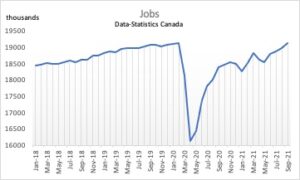

Jobs numbers rebound to pre-pandemic levels but labour troubles remain
CanadaNews Oct 22, 2021 Hansil Mehta

Canada’s employment numbers rebound back to pre-pandemic levels according to Statistics Canada after an increase of 157,000 jobs in September. This major milestone was reached amid a labour shortage with over 800,000 job vacancies reported in second quarter of this year.
Leah Nord, senior director of workforce strategies and inclusive growth at the Canadian Chamber of Commerce, says the latest growth in job numbers is encouraging. The increase means the job market is heading in the right direction toward filling vacant positions, which is key to inclusive growth and economic recovery.
“It’s not great news but it’s definitely good news,” Nord says.
Three million jobs were lost in March and April 2020 due to COVID-19, all of which are now recovered with many more job positions remaining to be filled.
“The job market is hot,” says Michael French, regional director for Robert Half Canada, a recruitment agency.
French says unemployment levels are “astronomically low” in some sectors such as tech, accounting, finance and business administration.
Overall unemployment in Canada is at 6.9 per cent according to Statistics Canada. But, according to French, the unemployment rate is as low as 2.5 per cent in some of the hot sectors.
“In general, there is a very strong hiring environment in both the professional service, warehousing and light industrial and heavy industrial markets,” French says. “It’s happening everywhere.”
The Statistics Canada report also highlights that almost 400,000 people are classified as long-term unemployed, more than double pre-pandemic levels.
Nord says it is crucial to understand why these people are not finding jobs despite so many vacancies.
“We have jobs without people and people without jobs,” Nord says.
She says it could turn out that a little bit of job training or getting new micro-credentials can help unemployed people get these jobs. But determining solutions requires a better understanding of the cause of this problem.
“These aren’t people who are retiring or choosing to leave the job market,” Nord says. “They want work, so we need to help them.”
French agrees. He says many companies have upgraded and invested in new technologies in the past year and are now requiring people with higher skill set and stronger tech skills.
“They’re looking to achieve more efficiency or more production out of fewer people,” French says on why there might be higher rate of long-term unemployment.
One sector that saw a drop in employment is accommodation and food services sector. It saw a decline of 2.5 per cent, or 27,000 jobs, in September according to Statistics Canada.
Nord says it has been tough for tourism and restaurants particularly due to COVID-19 restrictions.
Nord believes COVID-19 relief programs could be another factor. However, she says these programs are not the only factor, and she would like the programs run for a little longer — perhaps with modifications so they not only support people but also help them get new skills and connect with the labour market.
“We at the Canadian Chamber (of Commerce) would like to see them continue for a little bit longer,” Nord says. “But we also have the opportunity to look further and beyond and set ourselves up for success long term.”









